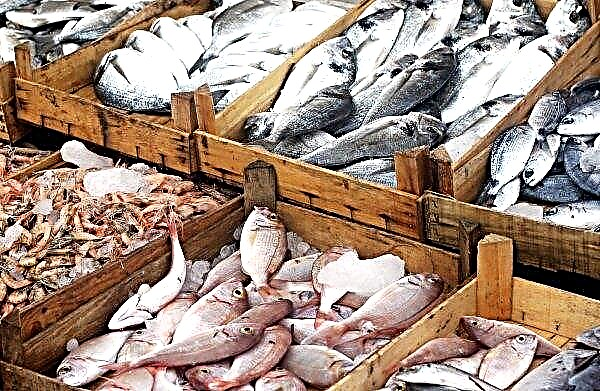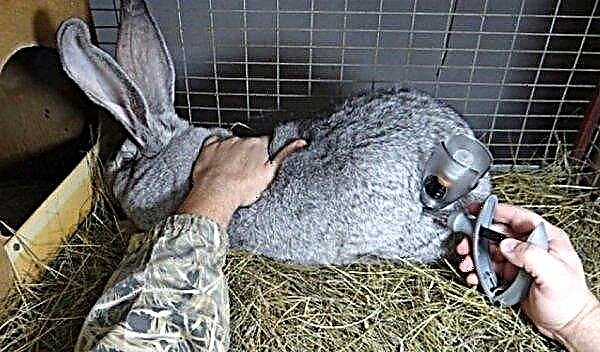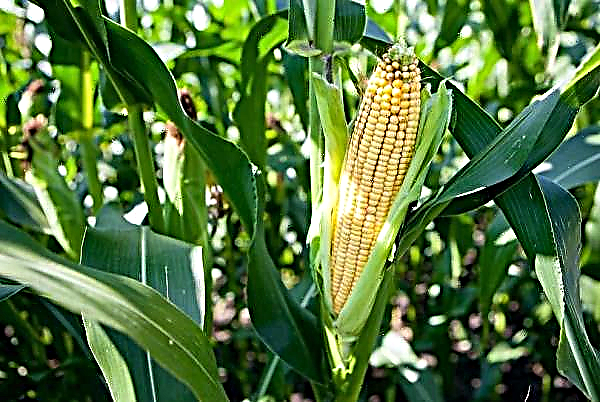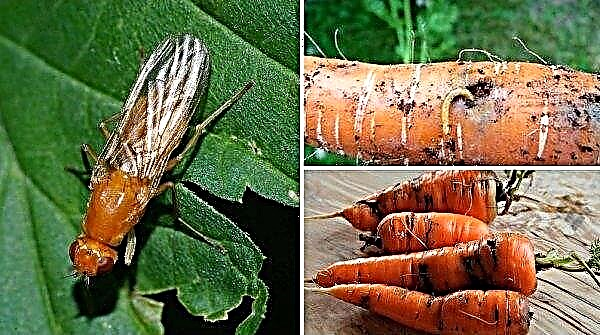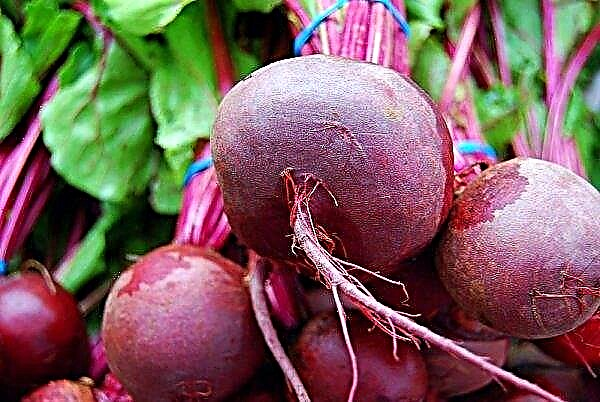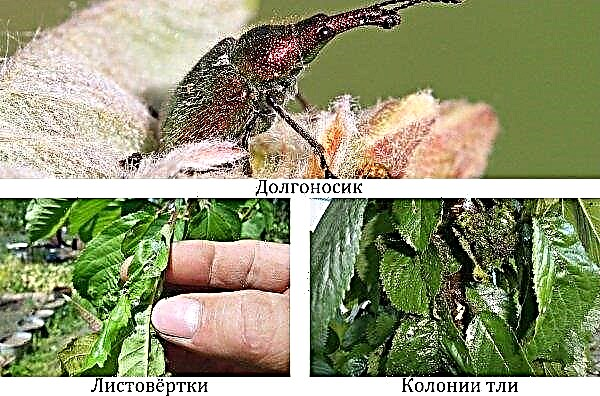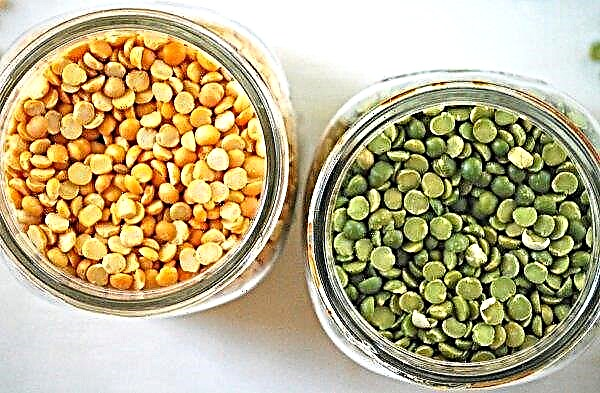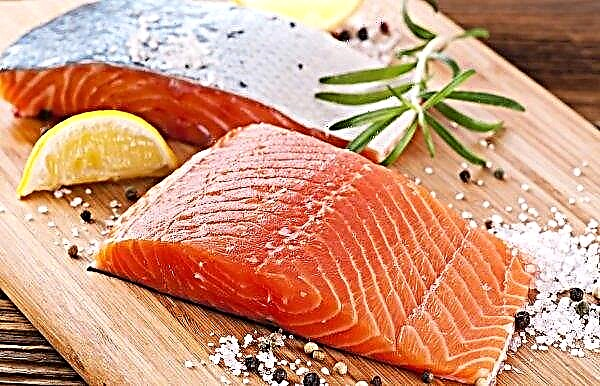Old tested varieties, available for many years, do not let gardeners and always give the expected result. Such varieties include the Rodnichok hybrid of cucumbers, known since Soviet times. We learn about the Rodnichok variety of cucumbers, its description and basic characteristics, advantages and disadvantages, how to grow and harvest.
Characterization and description of the variety
Refers to bee-pollinated hybrids of predominantly female type flowering mid-early ripening. From the appearance of seedlings to the appearance of fruits passes 50–55 days. It has great growth power. Forms three-meter lashes that are not particularly branching and give up to 5 side shoots.
At each node, 2-3 fruits of a spindle-shaped or cylindrical shape are tied, whose length reaches 9–12 cm. The average mass of cucumbers is 100–105 g. They have no bitterness and voids, they crunch pleasantly. Therefore, they like to use them for preservation and salting, although you can eat fresh. The fruits have a slight tuberosity on the surface, a green color with longitudinal stripes of light tone. Productivity can reach 25 kg with 1 m².Did you know? Cucumbers grown in open ground contain 15 kcal / 100 g, and greenhouses - 11 kcal / 100 g. Sour and pickled products will contain 11–13 kcal / 100 g. The calorie content of pickled cucumbers is much higher and, depending on the composition of the marinade, may contain from 18 to 130 kcal / 100 g.
The variety is resistant to cucumber diseases such as bacteriosis, olive spotting, anthracnose.
A characteristic feature of the hybrid is the cucumbers commensurate with each other, which look good in preservation as a whole. In sheltered soil, the variety gives maximum productivity, and in open beds it is noticeably lower.
Video: characteristics of the cucumber fontanel variety
Advantages and disadvantages
- The advantages of the hybrid of cucumbers Rodnichok include the following:
- presentation and taste of the fruit;
- unpretentiousness;
- good transportability and durability;
- the possibility of growing in open and protected ground;
- high productivity (especially in greenhouses);
- resistance to diseases and heat;
- universality of use.
- Not without flaws:
- with a lack of moisture, the fruits may begin to bitter;
- decrease in yield in open beds;
- needs pollination;
- the inability to use the collected seed material.
Optimal time for landing
The sowing time of cucumber seeds in the soil or seedlings depends on various factors - the method of cultivation (open or protected soil), climate, terrain, weather. For example, in the middle zone of the Russian Federation seedlings and seed are planted on unprotected beds in early June. Cucumber seedlings can be planted a couple of weeks earlier in an unheated greenhouse.
Seeds for seedlings are sown a month before these dates, that is, approximately in early May, since the most optimal age for planting is 20–25 days from the appearance of seedlings. Such a plant already has 2-3 developed leaves. Soil temperature in open or protected ground should be at the level of + 16 ... + 18 ° С.
In southern regions, which differ in early spring, seeds can be sown directly into the ground in early to mid-April. In any case, sowing cucumbers directly on the beds should not be earlier than the soil warms up to + 14 ° С.
Important! Take your time to plant the seeds before the onset of heat. They may die during long periods of lying in the ground without ever germinating.
To be safe, the seeds in the beds are sown in several periods, especially if the weather is changeable. For a more extended production, you can sow cucumbers in a few terms, but no later than mid-summer.
Planting and growing cucumbers
How you will sow the seeds of Rodnichok cucumbers depends on the method of cultivation. For an earlier harvest, seedlings are preferred, although you can sow directly on the beds.
Planting seedlings
For seedlings of cucumbers, you need to take light fertile neutral soils. They are sold everywhere in stores, but you can cook them yourself. The soil mixtures for growing this crop are made from peat, humus, overripe manure and turf. You can mix humus, turf and manure in a ratio of 7: 1: 2.
Before planting, the seed recommends keeping it for half an hour in a weak solution of potassium permanganate and rinsing if the manufacturer has not yet etched them. Then they should be sprouted, wrapped in a damp cloth to make sure they are germinating and get early seedlings.
When they hatch, they are immediately planted in a separate container of 1-2 seeds to a depth of about 2 cm. The extra sprout is then removed. Dishes for seedlings should be taken in a volume of about 0.4-0.5 liters. In it, it will grow before landing. Pick-up is not recommended.
The container with crops is first put in a warm place with a temperature of + 20 ... + 25 ° C and covered with a film. When shoots appear, they are transferred to a cooler place with temperatures of +20 ... + 22 ° C during the day and + 15 ... + 16 ° C at night. It is recommended to water the seedlings in the morning with water at room temperature.
It will be useful for you to learn about other varieties of cucumbers:
After 20-25 days, plants can be planted. It is undesirable for seedlings to outgrow, as this worsens its survival. A week before planting, it is recommended to harden them on the balcony or open the window, but so that the draft does not blow on the plants. The soils of the beds on which the seedlings will be planted should be heated not lower than + 15 ° С.
Open Seed
Cucumbers plant on a sunny, windproof place. In the hot southern regions it is permissible to plant them in partial shade. It is undesirable to plant after other gourds or repeatedly in the same place. But planting after potatoes, tomatoes, peas and corn would be a good choice. It is worth paying attention that there is no stagnation of water on the site in rainy weather, as this can cause the appearance of fungal diseases, which will significantly reduce productivity. 
Cucumbers prefer light nutrient soils, so the land is prepared for them in the fall or a couple of weeks before planting. Organic matter is introduced into it (manure, humus, compost, peat, turf), ash and mineral fertilizers (superphosphate) will be useful.
Soil on the eve of sowing can be decontaminated with a solution of copper sulfate (1 tsp / 10 l).
Cucumber care after planting
Rodnichok cucumbers should be properly looked after for high yields. The agricultural technology of this vegetable crop is not something complicated, but the crop itself will not grow.
Important! When growing a hybrid of cucumbers, Rodnichok in a shelter there must provide access to pollinating insects. Otherwise, you have to pollinate manually.
Rodnichok cucumbers are recommended to be sprayed with sugar or honey water during flowering - this is very attractive for bees and other pollinators.
Fertilizers and proper watering
This plant crop needs regular watering and top dressing. Watering is recommended every day. To do this, use warm, settled water. It should be watered under the root, so that moisture on the foliage does not cause sunburn. The recommended watering rate is approximately 1 bucket per plant. Watering itself is best done in the morning or evening.
In addition to watering, to obtain a good crop, it is necessary to carry out at least 5 top dressings for the entire growing period. Gardeners recommend feeding every 14 days.
The first time fertilizer is applied when seedlings appear. Organic fertilizers in the form of rotted manure or bird droppings are well suited for this. For its preparation, manure (bird droppings) is bred in water in a ratio of 2 to 1 and insisted for 14 days. Then such a fermented mixture in an amount of 0.5 l is stirred in a 10 l bucket of water. This solution is irrigated under the root. In this solution to enhance the effect, you can add 2 cups of wood ash. This component will not only feed the plant, but will also be a good prevention against the appearance of fungal diseases.
Superphosphate, nitrogen-containing and potassium fertilizers, and urea are well suited as mineral fertilizers. Foliar top dressing also gives a good result. You can independently prepare the following solution for spraying - 5 g of ammonium nitrate, 10 g of superphosphate and 8 g of potassium sulfate per 10 l bucket of water. Such a liquid mixture is useful for spraying every 2 weeks. For processing, only 1 bucket is enough - it is enough for 30 m² of planting.
Bush garter and shaping
To form a bush of cucumbers, it is imperative to pinch the shoot after the appearance of 6-7 leaves. The flake itself is produced, respectively, over 5 or 6 sheets. In this case, the bush stops growing upwards and gives more lateral shoots, on which the fruits will subsequently form.
To cucumbers when ripening did not lie on the ground and do not rot, the lashes of the plant must be tied. To do this, set trellis. First, wood or metal poles are driven into a line with a step of 1–1.3 m and a row spacing of 0.7 m. A wire is stretched between them in 2-3 rows. Plants should be in a row no closer than 30 cm to each other.
Did you know? The Chinese grow the most cucumbers - ¾ of all world production. Their volumes are 30 times more than in Russia, which took an honorable 2nd place.
Soil care
When caring for cucumbers, Rodnichok needs to loosen the soil after watering. This procedure contributes to a better flow of moisture and air to the plant. In order not to damage the root system, loosening the soil should be no deeper than 5-7 cm. During loosening, weed removal and hilling of the bush are carried out. This will protect the plant well from the occurrence of fungal diseases, and also improve the flow of water and nutrients. To protect the soil from drying out and the appearance of weeds, it is recommended to mulch. For mulch use sawdust, peat, humus, straw.
Disease and Pest Prevention
The variety has a fairly high resistance to various diseases and pests.
The emergence of many diseases and pests is often associated with violations in the care of plants. Phenomena such as low temperatures, temperature changes, inadequate watering (for example, cold water), increased humidity and stuffiness in the greenhouse, disturbance of crop rotation - all this negatively affects the growth and development of cucumbers, and can lead to the appearance of pathogenic fungi and bacteria.
To avoid such troubles, it is necessary to take the following preventive measures:- Disinfect seeds before planting.
- Adhere to all crop rotation rules.
- When growing cucumbers in a stationary greenhouse at least once a year, disinfect the soil, and also change the upper nutrient layer at least once every 2 years.
- In the autumn, after harvesting, it is imperative to remove the greenhouse from the remains of plant crops, weeds.
- To carry out preventive disinfection of the greenhouse and inventory itself.
- Make sure that there are beneficial microorganisms in the soil, as they inhibit the development of pathogens of various diseases by their activity. Therefore, it is necessary to make organic fertilizers in the form of compost, humus, and also spray the soil with a useful infusion of herbs (for example, nettle).
- Water only with standing warm water, avoiding stagnation of water.
- Be sure to tie the shoots of cucumbers.

Harvesting
The crop of the first cucumbers appears 50–55 days after planting. Harvest fruits every 2 days or daily.
Such an old proven hybrid as Rodnichok is still not losing ground. He gives high yields in greenhouses, but he needs to create conditions for pollination.Did you know? The first mention of cucumbers in Russia dates back to the 16th century, although this culture began to be grown by humans 6 thousand years ago.
Network user reviews
ADVANTAGES:
Good in any use.
LIMITATIONS:
No
I have been cultivating Rodnichok F1 cucumbers since the first days of my gardening experience. I tried and try to search for new seeds, but so far I have not found better. Rodnichka seeds never let me down. No matter what summer I always have cucumbers. They are good for any use, both for fresh consumption and for seaming. Just yet, my mother advised me to plant seeds of Libela cucumbers in the garden along with Rodnichka, I do this all the time, two rows of fontanel and one row of leaf. Maybe this is the success of my harvest. Only Libela cucumbers themselves do not always succeed. I plant seeds in the open ground in early May and cover with white covering material, this gives quick amicable shoots. If night frosts are transmitted, and this happens in May, and sometimes in June, then I cover them with oilcloth on top for the night. You can make a temporary greenhouse, under the arcs and cover with oilcloth, if this is not possible to come to the site when necessary. I completely remove the covering material from the cucumber garden after June 15, when there is no threat of night frost anymore. I noticed, most importantly, plant the cucumbers earlier, somewhere from April 29 to May 5 (I look at Easter, the earlier this holiday , the earlier I plant), then the harvest will be. There is a saying "plant cucumbers on Pakhom, you will wear it with fur", Pakhom is a church holiday on May 28. Only this saying does not justify itself. How many times have I tried to plant cucumbers on this day, but did not get the desired result.

